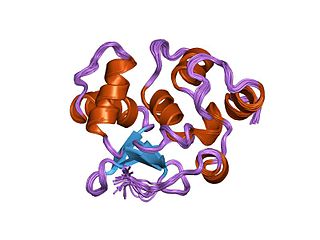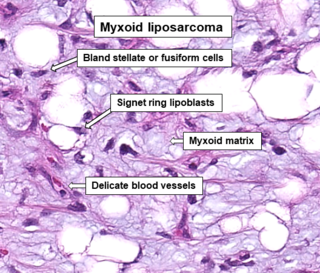
An oncogene is a gene that has the potential to cause cancer. In tumor cells, these genes are often mutated, or expressed at high levels.

A fusion gene is a hybrid gene formed from two previously independent genes. It can occur as a result of translocation, interstitial deletion, or chromosomal inversion. Fusion genes have been found to be prevalent in all main types of human neoplasia. The identification of these fusion genes play a prominent role in being a diagnostic and prognostic marker.

Acute myeloblastic leukemia with maturation (M2) is a subtype of acute myeloid leukemia (AML).

Ewing sarcoma is a type of pediatric cancer that forms in bone or soft tissue. Symptoms may include swelling and pain at the site of the tumor, fever, and a bone fracture. The most common areas where it begins are the legs, pelvis, and chest wall. In about 25% of cases, the cancer has already spread to other parts of the body at the time of diagnosis. Complications may include a pleural effusion or paraplegia.

MN1 is a gene found on human chromosome 22, with gene map locus 22q12.3-qter. Its official full name is meningioma 1 because it is disrupted by a balanced translocation (4;22) in a meningioma.

Homeobox protein Hox-A9 is a protein that in humans is encoded by the HOXA9 gene.

Friend leukemia integration 1 transcription factor (FLI1), also known as transcription factor ERGB, is a protein that in humans is encoded by the FLI1 gene, which is a proto-oncogene.

α-Methylacyl-CoA racemase is an enzyme that in humans is encoded by the AMACR gene. AMACR catalyzes the following chemical reaction:

Anaplastic lymphoma kinase (ALK) also known as ALK tyrosine kinase receptor or CD246 is an enzyme that in humans is encoded by the ALK gene.

ERG is an oncogene. ERG is a member of the ETS family of transcription factors. The ERG gene encodes for a protein, also called ERG, that functions as a transcriptional regulator. Genes in the ETS family regulate embryonic development, cell proliferation, differentiation, angiogenesis, inflammation, and apoptosis.

Protein SSX2 is a protein that in humans is encoded by the SSX2 gene.

Ubiquitin carboxyl-terminal hydrolase 6 (USB6), also termed TRE17 and Tre-2, is a deubiquitinating enzyme that in humans is encoded by the hominid USP6 gene located at band 13.2 on the short arm of chromosome 17. Deubiquitinating enzymes (DUBs) are enzymes that act within cells to remove ubiquitins from various functionally important proteins. Ubiquitin enzymes add ubiquitin to these proteins and thereby regulate their cellular location, alter their activity, and/or promote their degradation. By deubiquitinating these proteins, DUBs counter the effects of the ubiquinating enzymes and contribute to regulating the actions of the targeted proteins. In normal adult tissues, USP6 is highly expressed in testicle tissue, modestly expressed in ovarian tissue, and absent or minimally expressed in other tissues. It is also highly expressed in fetal brain tissue. The specific functions of USP6 are poorly defined primarily because its presence is restricted to primates: there are no available animal models to determine the effects of its deletion, although some studies suggest that UPSP6 contributes to normal brain development. In all events, USP6 has gained wide interest because of its abnormally increased expression by the neoplastic cells in various tumors derived from mesenchymal tissue.

Protein SSX1 is a protein that in humans is encoded by the SSX1 gene.

Proline-rich protein PRCC is a protein that, in humans, is encoded by the PRCC gene.

In the field of molecular biology, the ETSfamily is one of the largest families of transcription factors and is unique to animals. There are 29 genes in humans, 28 in the mouse, 10 in Caenorhabditis elegans and 9 in Drosophila. The founding member of this family was identified as a gene transduced by the leukemia virus, E26. The members of the family have been implicated in the development of different tissues as well as cancer progression.

Pvt1 oncogene, also known as PVT1 or Plasmacytoma Variant Translocation 1 is a long non-coding RNA gene. In mice, this gene was identified as a breakpoint site in chromosome 6;15 translocations. These translocations are associated with murine plasmacytomas. The equivalent translocation in humans is t(2;8), which is associated with a rare variant of Burkitt's lymphoma. In rats, this breakpoint was shown to be a common site of proviral integration in retrovirally induced T lymphomas. Transcription of PVT1 is regulated by Myc.

A myxoid liposarcoma is a malignant adipose tissue neoplasm of myxoid appearance histologically.

Solute carrier family 45 member 3 (SLC45A3), also known as prostate cancer-associated protein 6 or prostein, is a protein that in humans is encoded by the SLC45A3 gene.
Chimeric RNA, sometimes referred to as a fusion transcript, is composed of exons from two or more different genes that have the potential to encode novel proteins. These mRNAs are different from those produced by conventional splicing as they are produced by two or more gene loci.
Yashar Sharifi Niknafs is an American scientist, coder, and businessman. He currently serves as the chief executive officer of Lynx Dx, Inc., one of the largest providers of COVID-19 PCR testing in the state of Michigan.
















